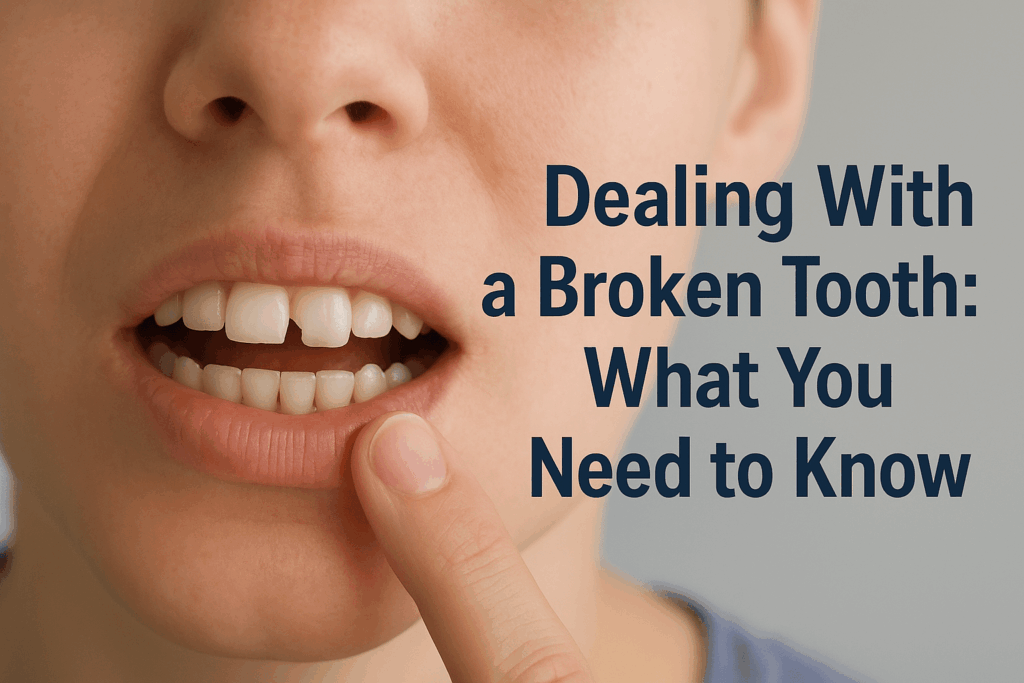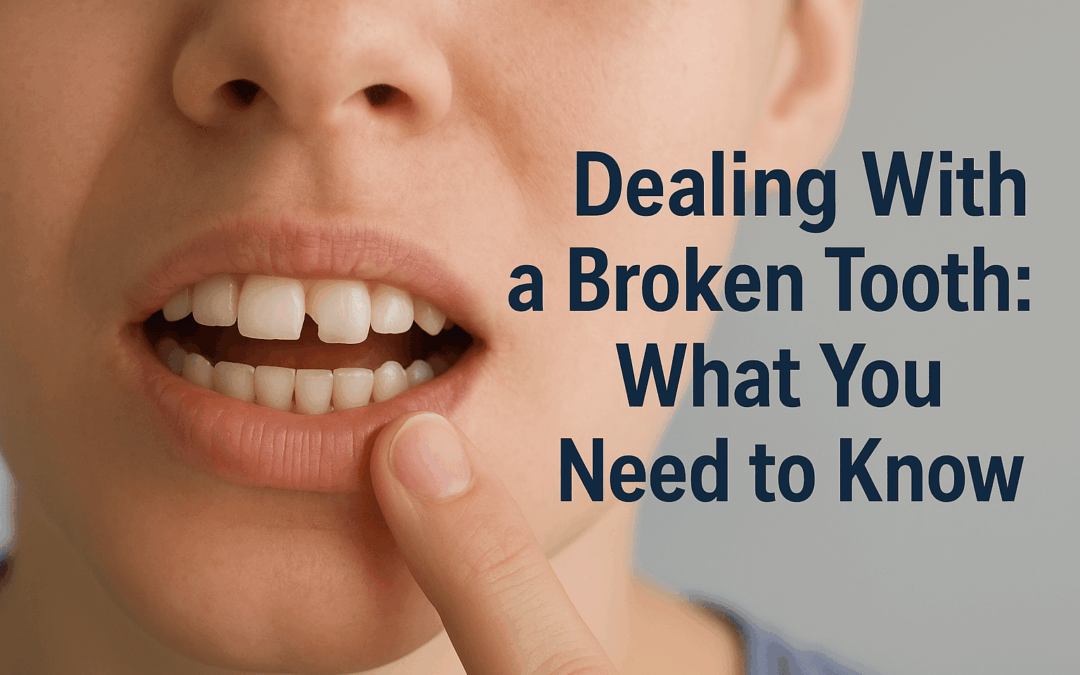
Experiencing a broken tooth can be alarming, painful, and sometimes even embarrassing. Whether it’s due to an injury, biting down on something hard, or a hidden cavity weakening the structure, a broken tooth is a dental emergency that requires prompt attention. At BlueJay Family Dental in Council Bluffs, IA, many patients are surprised to find that broken teeth are more common than they might think. Understanding what causes a tooth to break, the different types of tooth fractures, and what to do when it happens can make a significant difference in protecting your oral health.
Common Causes of a Broken Tooth
Tooth enamel is one of the hardest substances in the human body, but it isn’t indestructible. Over time or under the right (or wrong) circumstances, it can crack or break. One of the most common causes is physical trauma—this could come from a sports injury, a fall, or even something as mundane as biting down on an ice cube or unpopped popcorn kernel. Grinding your teeth at night, a condition known as bruxism, can also slowly wear down your enamel and make your teeth more prone to breaking.
Another often-overlooked factor is tooth decay. Cavities weaken the internal structure of a tooth, making it more vulnerable to breaking under pressure. Even seemingly minor dental problems can escalate into bigger issues when a compromised tooth structure finally gives way. Old dental restorations, such as large fillings, can also increase the risk of breakage if they no longer provide the necessary support.
Types of Tooth Fractures
Not all broken teeth are the same. Understanding the type of fracture can help determine the urgency and type of treatment needed. One of the most minor forms is a craze line, which is a small, superficial crack in the enamel. These usually don’t require treatment and are often considered cosmetic. More serious is a fractured cusp, which occurs when a portion of the chewing surface of the tooth breaks off, often around a filling. These typically don’t involve the pulp (nerve) of the tooth, so they might not be painful but still need repair.
A cracked tooth can extend from the chewing surface vertically toward the root. If the crack reaches the pulp, it can be quite painful and may require more intensive treatment. A split tooth occurs when a cracked tooth is left untreated and the crack progresses until the tooth splits into distinct segments. These are often not salvageable. Finally, a vertical root fracture begins in the root of the tooth and extends upward. These are often harder to detect and may not show symptoms until the surrounding bone and gum become infected.
Symptoms to Watch Out For
While a broken tooth might be obvious in some cases—like when a chunk of the tooth falls out—other times it’s more subtle. Common symptoms include sharp pain when biting down, sensitivity to hot or cold foods, and intermittent discomfort that may come and go. Sometimes the pain is not immediate but develops over time as the nerve becomes irritated or infected.
Other indicators might include visible damage to the tooth surface or a feeling that something is “off” when you run your tongue over the tooth. Swelling in the gums around a particular tooth can also signal an underlying fracture or infection. Because symptoms vary depending on the type and severity of the break, it’s important not to ignore any unusual sensations or visible changes in your mouth.
What to Do Immediately After Breaking a Tooth
The moments following a dental injury can be stressful, but knowing what to do can help prevent further damage and reduce pain. If a piece of your tooth breaks off, try to retrieve it and store it in a small container with milk or your own saliva. Rinse your mouth with warm water to cleanse the area, and if there’s any bleeding, apply gentle pressure with gauze or a clean cloth.
For pain and swelling, over-the-counter pain relievers and a cold compress on the outside of the cheek can help. Avoid chewing on the affected side and stick to soft foods until you can be seen by a dentist. Even if the pain subsides, you should still have the tooth examined. Damage that seems minor can sometimes mask more serious issues under the surface.
Treatment Options for Broken Teeth
Treatment for a broken tooth depends heavily on the type and severity of the damage. For minor chips, cosmetic bonding may be sufficient. This procedure involves applying a tooth-colored resin to restore the shape and appearance of the tooth. For more substantial damage, a dental crown might be required. Crowns are custom-made caps that cover the entire tooth, providing protection and restoring function.
In cases where the pulp is exposed or infected, a root canal might be necessary before a crown can be placed. If the tooth is too badly damaged to be saved, extraction may be the only option, followed by a dental implant or bridge to restore the missing tooth. Your dentist will conduct a thorough examination, often including X-rays, to determine the best course of action.
Preventing Future Breaks
While some causes of broken teeth are unavoidable, there are many steps you can take to reduce your risk. Good oral hygiene is essential—brushing twice daily, flossing, and regular dental checkups help maintain strong enamel and catch early signs of decay. Wearing a mouthguard during sports can prevent trauma, and if you grind your teeth at night, a nightguard can protect your teeth from excessive pressure.
Also, be mindful of what you eat. Avoid chewing on hard objects like ice, pens, or hard candies. If you already have dental restorations, have them checked regularly to ensure they remain stable and effective. Keeping your mouth healthy is an ongoing effort that pays off in long-term protection.
When to Seek Emergency Care
It’s crucial to recognize when a broken tooth requires immediate dental attention. Severe pain, swelling, bleeding, or signs of infection such as pus or a bad taste in the mouth indicate the need for urgent care. A broken tooth that results in a sharp edge can also cut your tongue or cheeks, so even without pain, it may be an emergency.
Delaying treatment can lead to worsening problems, including infection that spreads to other parts of the body. While some minor fractures can wait a day or two for care, significant trauma or discomfort should not be ignored. In Council Bluffs, IA, being familiar with where to go and who to contact can make all the difference when dealing with a dental emergency.
Conclusion
Dealing with a broken tooth can be a distressing experience, but understanding the causes, symptoms, and available treatments can empower you to take the right steps. Whether the damage is minor or severe, prompt attention and proper care are essential to protecting your oral health. If you’re in Council Bluffs, IA, and find yourself facing this situation, knowing that professionals like Dr. Steven Fidone at BlueJay Family Dental are part of your community can provide peace of mind. Be proactive, stay informed, and don’t wait to address a dental emergency—it’s your first step toward recovery and long-term oral wellness.
Resources
American Dental Association. (2020). Cracked Teeth. MouthHealthy.
Opdam, N. J., Loomans, B. A., & Roeters, F. J. (2008). The fate of fractured teeth: A retrospective study. Operative Dentistry.
Cameron, C. E. (1964). The cracked tooth syndrome: Additional findings. Journal of the American Dental Association.

